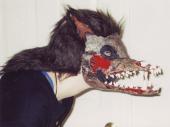Materials: Rubber Latex

Natural rubber latex comes as a liquid, and air-dries to form a flexible rubber material and, once dried, cannot be re-liquified. It can be used to make masks, prosthetic appliances, texture stamps, and soft molds.
Tips and things to consider:
- Some people are allergic to latex! If you've ever had a reaction to latex gloves, prosthetics, or Halloween masks, steer clear of using this material.
- Liquid latex must be used in a well-ventilated area. It has a heavy ammonia odor, which will fade once it's dry. The final latex rubber product will have a faint rubbery scent.
- Latex cures by drying, so it needs enough surface area exposed in order to dry properly. If using a mold, the mold should be a porous material, like UltraCal 30 plaster, which will pull the moisture from the latex. Latex must be cast in fairly thin layers (no thicker than a few millimeters), or you risk it not drying properly.
- Latex deteriorates over time, both in its liquid form and in its final rubber form. A well-cared for latex mask can stay in good condition for years, but older latex pieces will eventually start to stiffen and may crack with age. Liquid latex separates over time, so its best to stir it each time you use it. Even so, the shelf life of liquid latex is limited and it can become unusable within a couple years.
- It shrinks a bit as it dries. You will notice latex start to pull away from the mold on its own as it dries. It's not a huge amount of shrinkage, but if you need a part to be a precise size, consider other materials.
- To prevent latex from sticking to itself, brush it with talcum powder before pulling the piece from its mold.
- You can tint latex with colorants before pouring a mold. I've even successfully tinted it with acrylic paint.
While it may seem like there's a lot of negatives on that list, latex is a versatile material and can be used to create some amazing things!
Examples:

|
My Garrus mask is made almost entirely from latex. |

|
I also used latex to made a set of useful texture stamps. |

|
Both the mask face and the pawpads on my white werewolf costume are made from latex. |

|
I used a slightly different technique for my Callisto mask, dipping pieces of tissue in latex to form a wrinkled, zombie-ish skin. The teeth are cast latex. |
If you found this helpful, consider leaving us a tip or becoming a Patron! Your generosity helps our small business thrive.
Categories: Costuming, Materials and Tools, Tutorials, Materials, and Tools
Tags: casting, latex, maskmaking, masks, molding, natural, rubber, rubber latex
Live Date: 8/23/2013 |
Last Modified: 9/29/2022